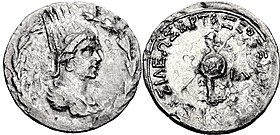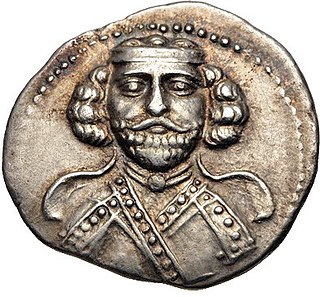
Phraates III, was King of Kings of the Parthian Empire from 69 BC to 57 BC. He was the son and successor of Sinatruces.

Phraates IV was King of Kings of the Parthian Empire from 37 to 2 BC. He was the son and successor of Orodes II, and was given the throne after the death of his brother Pacorus I. Phraates IV soon murdered all his brothers, and also possibly his father. His actions alienated the Armenians and also some of his nobles, including the distinguished Monaeses, who fled to the Roman triumvir Mark Antony, but shortly returned and reconciled with Phraates IV.

Artavasdes II, also known as Artavazd II, was king of Armenia from 55 BC to 34 BC. A member of the Artaxiad dynasty, he was the son and successor of Tigranes the Great, who ascended the throne of a still powerful and independent state. His mother was Cleopatra of Pontus, thus making his maternal grandfather the prominent King of Pontus Mithridates VI Eupator. Like his father, Artavasdes continued using the title of King of Kings, as seen from his coins.

Artabanus II, incorrectly known in older scholarship as Artabanus III, was King of Kings of the Parthian Empire from 12 to 38/41 AD, with a one-year interruption. He was the nephew and successor of Vonones I. His father has been variously identified as a Dahae or Atropatid prince, whilst his mother was a daughter of the Parthian King of Kings Phraates IV.

Vonones I was an Arsacid prince, who ruled as King of Kings of Parthian Empire from 8 to 12, and subsequently as king of Armenia from 12 to 18. He was the eldest son of Phraates IV and was sent to Rome as a hostage in 10/9 BC in order to prevent conflict over the succession of Phraates IV's youngest son, Phraataces.
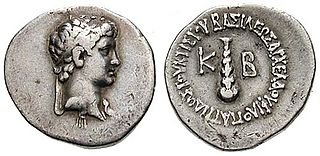
Archelaus was a Roman client prince and the last king of Cappadocia. He was also husband of Pythodorida, Queen regnant of Pontus.

Artavasdes I was the Artaxiad king of Armenia from approximately 160 BC to 115 BC. He was the son and successor of Artaxias I. Little is known about his reign. He is the subject of ancient Armenian folk traditions, which are recorded by later Armenian authors.

Marcus Antonius Polemon Pythodoros, also known as Polemon II of Pontus and Polemon of Cilicia, was a prince of the Bosporan, Pontus, Cilicia, and Cappadocia. He served as a Roman client king of Pontus, Colchis, and Cilicia.
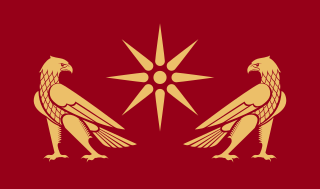
The Artaxiad dynasty ruled the Kingdom of Armenia from 189 BC until their overthrow by the Romans in 12 AD. Their realm included Greater Armenia, Sophene and, intermittently, parts of Mesopotamia. Their main enemies were the Romans, the Seleucids and the Parthians, against whom the Armenians conducted multiple wars. Under the Artaxiad king Tigranes the Great, the Kingdom of Armenia reached its greatest territorial extent, extending for a brief period from the Caspian to the Mediterranean Sea.
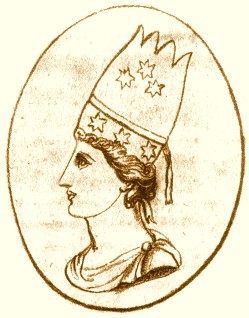
Erato was a queen of Armenia from the Artaxiad dynasty. She co-ruled as Roman client queen in 8–5 BC and 2 BC–AD 1 with Tigranes IV. Erato reigned alone in 1–2 AD. After living in political exile for a number of years, she co-ruled as Roman client queen from 6 until 12 with Tigranes V, her distant paternal relative and possible second husband. She may be viewed as one of the last hereditary rulers of her nation.
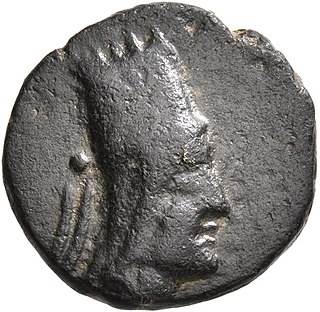
Tigranes I was an Artaxiad king of Armenia at the end of the 2nd and the beginning of the 1st century BC. Few records have survived about his and his predecessor Artavasdes I's reign, which has led to some confusion. Some modern scholars have doubted that such a king reigned at all. Other historians, such as Hakob Manandian, David Marshall Lang and Rouben Paul Adalian consider him a real figure but differ or are uncertain on the exact dates of his reign. Although it has been proposed that Tigranes I reigned from 123 BC to 96 BC, this view has been criticized. Another suggestion is that Tigranes I ruled in 120 BC - 95 BC and this has been recently corroborated by historian Christian Marek.

Tigranes III was a prince of the Kingdom of Armenia and member of the Artaxiad dynasty who served as a Roman client king of Armenia.
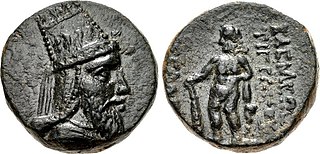
Tigranes V, also known as Tigran V was a Herodian prince who ruled as a Roman client king of Armenia from 6 AD to 12 AD.

Tigranes IV was a prince of the Kingdom of Armenia and member of the Artaxiad dynasty who served as a Roman client king of Armenia from 8 BC until 5 BC and 2 BC until 1 AD.

Artavasdes IV of Armenia; also known as Artavasdes II of Atropatene; Artavasdes II of Media Atropatene and Armenia Major; Artavasdes II, and Artavasdes was an Iranian prince who served as King of Media Atropatene. During his reign of Media Atropatene, Artavasdes also served as a Roman Client King of Armenia Major.

Artavasdes I of Media Atropatene, also known as Artavasdes I of Atropatene and Artabazus, was a prince who served as a king of Media Atropatene. Artavasdes I was an enemy of King Artavasdes II of Armenia and his son Artaxias II. He was a contemporary with the Ptolemaic Greek Queen Cleopatra VII and Roman Triumvir Mark Antony, as Artavasdes I was mentioned in their diplomatic affairs.
Archelaus was a Cappadocian prince and a Roman client king of Cilicia Trachea and Eastern Lycaonia. He is sometimes called Archelaus Minor and Archelaus II to distinguish him from his father Archelaus of Cappadocia.
Ariobarzanes II of Atropatene also known as Ariobarzanes of Media; Ariobarzanes of Armenia; Ariobarzanes II; Ariobarzanes II of Media Atropatene and Ariobarzanes was king of Media Atropatene who ruled sometime from 28 BC to 20 BC until 4 and was appointed by the Roman emperor Augustus to serve as a Roman client king of Armenia from 2 AD until 4.

Artavasdes III was a king of the Kingdom of Armenia who ruled from 5 to 2 BC. He may have been a son of the Artavasdes II of Armenia, thus a brother of Artaxias II and Tigranes III and an uncle of Tigranes IV. Augustus had commanded the enthronement of Artavasdes III as Armenian king, or soon after, in the effort to supplant Tigranes IV and Erato. Artavasdes was forcibly driven out, presumably by supporters of Tigranes IV backed by Parthia.
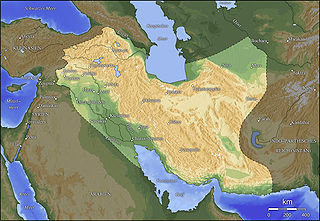
Augustus' Eastern policy represents the political-strategic framework of the eastern imperial borders of the Roman Empire at the time of Augustus' principate, following the occupation of Egypt at the end of the civil war between Octavian and Mark Antony.
